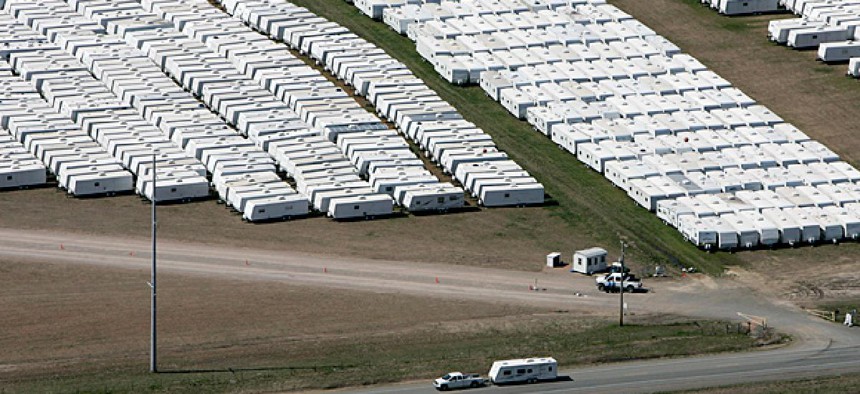FEMA trailers head to Sandy-ravaged communities
The mobile homes, ubiquitous during Katrina, are designed to provide temporary housing.
Federal Emergency Management Agency trailers are heading to East Coast communities hit hard by megastorm Sandy to provide temporary housing for people the disaster left homeless.
The agency is deploying the mobile homes, which became ubiquitous on the Gulf Coast after Hurricane Katrina in 2005, to give people displaced by the storm another temporary housing option, said FEMA chief Craig Fugate during a conference call with reporters Thursday. The agency also is providing rental assistance to disaster victims, which can be used for apartments, hotels or motels.
More than $300 million is going toward housing aid for Sandy victims, Fugate said, which is the lion’s share of the $320 million in assistance the agency has provided so far. Fugate said he did not know offhand how many people to date have received temporary housing assistance or how many trailers ultimately would be needed. People typically live in the manufactured housing for up to 18 months, though many Katrina victims lived in trailers for years.
Fugate also said Wednesday’s nor’easter, which hit many of the same areas walloped by Sandy a little more than a week ago, created more power outages and temporarily shut down disaster response operations.
Reporters on the conference call said they’d received information from frustrated disaster victims who had not yet received FEMA housing assistance. “It’s a hierarchy of need,” Fugate said, adding the priority now is providing shelter for those who are homeless as a result of the storm. He told reporters to let the agency know about people who are not in their homes and need a place to stay.
FEMA trailers have a mixed reputation. While the mobile homes can provide immediate and relatively safe shelter for victims, they also were criticized after Katrina for having hazardous levels of formaldehyde, a known carcinogen linked to numerous health problems, including breathing difficulties. This past spring, a federal judge approved a $42.6 million settlement in a class action lawsuit against companies that provided trailers to FEMA to house victims of hurricanes Katrina and Rita.
Fugate referred a question on the quality of the trailers being deployed to house Sandy victims to the Housing and Urban Development Department, since that agency regulates manufactured housing standards.
Disasters create different categories of need and the government’s way of prioritizing those needs can perplex victims. Some are left homeless and need immediate temporary housing assistance; others are able to live in their homes but must wait for FEMA inspectors to assess damage if they do not have insurance. FEMA is only one of several agencies that administer disaster assistance, and figuring out who is eligible for what kind of aid often is as confusing and overwhelming as the disaster itself. For instance, the Agriculture Department has more than a dozen disaster assistance programs ranging from crop insurance to farm emergency loans; HUD provides housing vouchers to displaced individuals and community development block grants to states; and the Small Business Administration hands out business, housing and property disaster loans. FEMA offers various types of aid, most notably through its Individuals and Households assistance program.




